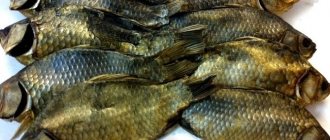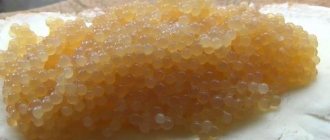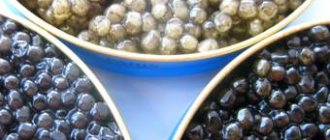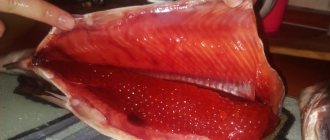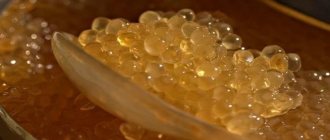An amazing, unusual and amazing delicacy is caviar. Its aftertaste is unique and exquisite. Pike, red, sturgeon... It literally melts in your mouth, exploding with salty juice. The bright taste also matches the beneficial properties. Caviar is considered a dietary product and is a source of vigor and life-giving energy. Caviar prepared at home is much healthier and tastier than store-bought caviar. And if there are avid fishermen at home, you can prepare the delicacy yourself. But before delving into cookbooks, caviar needs to be cleaned of film.
Cleaning features for various fish
Each type of fish caviar has its own subtleties. Pink salmon or chum salmon caviar is large in size. For processing, use a sieve and a fork.
- The sieve is placed at the bottom of a plastic container. Washed caviar is placed on it. The yoke is pryed with a fork or slightly cut. The eggs are scattered over a sieve in an even layer, removing large pieces of film.
- Place the container with the sieve in the sink and water it with cold water. The eggs should not float over the edge of the sieve, so the container should not be completely filled with liquid.
- Using a large spoon, mix the contents of the sieve, removing debris. The eggs can be separated from the film with a fork.
- The caviar is strained into a fine-mesh sieve, filled with water and washed several times until the film is completely removed.
- Spoiled eggs are removed. The product is washed again with clean water.
The method of cleaning with a mixer using a colander is also effective. The product is also filtered through a fine sieve and washed to clean water. Small particles of film are removed by hand.
Why clean the film and how to do it
The film that covers fish eggs is called yastyk. Caviar is cleared of it solely for practical reasons. If a film remains on the eggs, the product will be bitter. And if the caviar is not removed, then the usual friability of caviar in jars and snacks will not occur.
The method used on fish farms is considered correct and convenient. Tons of fish and tens of kilograms of caviar pass through the hands of professionals. You need to remove pits quickly and efficiently in order to preserve the taste and appearance of the product. To do this, use nets with holes larger in size than the eggs. A kind of colander. At home, we suggest using a sieve with large cells.
This is how caviar is cleaned in production
How to properly remove a jast at home
- We wash the caviar in the film with cold water.
- Carefully cut the yoke in several places.
- Take a sieve with large holes (the eggs should slide freely into the holes).
- Gently, without pressing, rub the caviar through a sieve. The jastik remains on the surface. The connecting film can be separated from the remaining eggs with a fork.
The method is used for cleaning pike, sturgeon, and salmon caviar. It is convenient and easy to use.
How to quickly and effectively clean caviar from film
We have already talked about the classic method of rubbing caviar through a sieve. Let's try other cleaning options.
A whisk and boiling water will remove the film
- Pour cold water into a large saucepan.
Pour cold water
Only 2 bags of caviar can be placed in the pan
Whisk the caviar in boiling water
The product is ready for salting
When using this method, it is important not to cook the caviar. Therefore, you need to act very quickly and carefully.
Remove films with a regular grater
In addition to the whisk, you can use a kitchen grater for small caviar (pike, crucian carp, perch, trout caviar).
- Using a coarse grater, grate the caviar in the film. We try to act carefully so as not to crush the eggs.
- The peeled ashtick remains on the surface of the grater. We throw it away.
- Add 1 tbsp caviar. l. salt and add hot water.
- Stir and leave for 20 minutes.
- Strain through a fine sieve. If there are small particles of film left in the mixture, remove them with a fork.
- There is some liquid left in the caviar, so leave it in the sieve for 10 minutes to let the water drain.
Cleansing at home
The most common method is using hot water. Just hot, not boiling water. Pour salt into slightly warmed water (1 tablespoon per liter of water), stir until completely dissolved. Place the caviar sacs into the saline solution, then whisk lightly with a fork or small whisk. During the whipping process, the yashtik will wrap around the fork, which is what was required. When the entire workpiece is cleaned, drain the water and remove the remaining film with your hands.
You always want to make a tasty and high-quality product. The most delicious snack is obtained when the eggs are separated from the film manually using a teaspoon or coffee spoon. The disadvantage of this method is that it takes a lot of time.
The best option for removing the crust is using a colander. You need to take a colander or a sieve whose holes are smaller than the eggs. Place the sieve (colander) in a pan with heated water (50-60 degrees, no more). The raw material needs to be heated a little, then stir the caviar in a circular motion with a fork, while wrapping the film around the fork. When all the films have been removed, remove the colander from the pan and leave to drain. The caviar should cool at room temperature - this way the natural taste and shape of the caviar will be preserved. As soon as the workpiece has cooled, you can start salting.
It happens that when cutting frozen fish, full caviar sacs are discovered. In this case, you need to pour boiling water over the yastyk and peel it off like peeling a tangerine. The film comes off easily without causing any hassle. The method is suitable for any eggs - both large and small. For larger eggs (chum, chinook, salmon), some housewives use a tennis racket. This is an unusual method, but at the same time, the eggs easily leak through the mesh, leaving behind an empty hole.
Features of caviar processing
- Before removing the oysters, red caviar must first be rinsed in a saline solution: for 1 liter of hot water we need 0.5 teaspoon of iodized salt. For black and river fish caviar such processing is not required.
- Dry the caviar by spreading it on a sieve or gauze at room temperature.
- Do not dry the purified product on paper napkins and towels, as the caviar will quickly stick to them.
- Experts advise not to fry peeled caviar, as it becomes hard, and suggest salting it.
- To salt caviar, if we are going to use it quickly, it is not at all necessary to keep the product in salt for several days. It is enough to soak the caviar in brine for 7–10 minutes: 2 tablespoons of salt per 1 liter of warm water. Dry and pour with sunflower oil.
- If we plan to store caviar in the refrigerator for more than 14 days, then we keep it in brine for 30 minutes.
Caviar is salted quickly, within 10–30 minutes
A pleasant surprise in the form of caviar when cutting fish will definitely please you now. After all, the methods we described will greatly facilitate the housewife’s work. Now crumbly homemade caviar on the festive table will surprise guests not only with its great taste, but also with its no less brilliant appearance.
An amazing, unusual and amazing delicacy is caviar. Its aftertaste is unique and exquisite. Pike, red, sturgeon... It literally melts in your mouth, exploding with salty juice. The bright taste also matches the beneficial properties. Caviar is considered a dietary product and is a source of vigor and life-giving energy. Caviar prepared at home is much healthier and tastier than store-bought caviar. And if there are avid fishermen at home, you can prepare the delicacy yourself. But before delving into cookbooks, caviar needs to be cleaned of film.
How to remove films from chum salmon eggs
If the integrity of the egg in a purchased pink salmon carcass is compromised, prepare a salt solution at the rate of a large heaped spoonful of salt per liter of water. The yashtik is washed in brine. Bursting eggs are carefully removed, trying not to touch whole grains. In a saline solution, damaged eggs turn white. The eggs are ripped open, whole eggs are removed and passed through a colander or sieve.
Both manual and automatic methods are suitable for cleaning trout eggs. When choosing the first, the water is boiled.
- The caviar bag is placed in the liquid as hot as possible, but at a temperature that the hand can withstand.
- The caviar separates from the film on its own. The ovary is torn, picking out the eggs with your hands, removing the partitions.
- Carefully remove the films, place the caviar on a sieve and leave until the liquid drains.
Features of caviar processing
- Before removing the oysters, red caviar must first be rinsed in a saline solution: for 1 liter of hot water we need 0.5 teaspoon of iodized salt. For black and river fish caviar such processing is not required.
- Dry the caviar by spreading it on a sieve or gauze at room temperature.
- Do not dry the purified product on paper napkins and towels, as the caviar will quickly stick to them.
- Experts advise not to fry peeled caviar, as it becomes hard, and suggest salting it.
- To salt caviar, if we are going to use it quickly, it is not at all necessary to keep the product in salt for several days. It is enough to soak the caviar in brine for 7–10 minutes: 2 tablespoons of salt per 1 liter of warm water. Dry and pour with sunflower oil.
- If we plan to store caviar in the refrigerator for more than 14 days, then we keep it in brine for 30 minutes.
Caviar is salted quickly, within 10–30 minutes
A pleasant surprise in the form of caviar when cutting fish will definitely please you now. After all, the methods we described will greatly facilitate the housewife’s work. Now crumbly homemade caviar on the festive table will surprise guests not only with its great taste, but also with its no less brilliant appearance.
Homemade fish caviar is much tastier than store-bought. And the cost is much better. The main difficulty is how to clean the caviar from the film and crust.
Separating the film from trout caviar
It is reasonable to use the automatic method using a mixer if you have extensive experience in processing caviar. Otherwise, the risk of damage to the integrity of the eggs is very high.
After using the mixer, the caviar is placed in a sieve, washed with cool water, and left until the liquid drains. When the product dries, you can add salt.
Pike caviar has small eggs.
- To remove films, use a sieve.
- The joint is washed and cut.
- Rub the product through a coarse sieve carefully so as not to crush the eggs.
- The remaining pieces of film are removed with a fork, twisting it in the container.
How to remove the film from pike caviar
Carp is processed similarly.
- To free the char caviar from the film, you will need brine brine prepared according to a special recipe. The water for it is boiled and cooled slightly.
- Then put a medium-sized peeled potato tuber into the liquid and add a little salt. When the vegetable floats to the surface, the brine is ready.
- It is important not to overcook the caviar in the brine: 5–10 minutes is enough.
- The potatoes are removed, the delicacy is poured with brine, stirring with a fork or whisking. The films wound around the fork are removed.
Coarse mesh sieve
You are lucky if you get red caviar from chum salmon or pink salmon. It is quite large in size and can be easily cleaned using the first method. But what to do if the caviar is fine-grained, for example pike. Let's figure out how to clean caviar from films at home using a sieve.
To begin with, the caviar in the bags is thoroughly washed under running water. Then the yastyk is carefully cut in some places, and the contents are placed in a sieve. Take a sieve with large holes so that the caviar can easily penetrate through them into the plate. Try to do everything as carefully as possible so as not to crush the eggs. The remains of the film bag will be visible when most of the eggs fall into the holes of the sieve. You can remove the crust with your hands or a fork.
Removing jastyk in salt water
- Prepare a brine solution: dissolve salt in boiling water in the ratio: 100 grams per 1 liter.
- Place the unpeeled caviar in a separate bowl.
- Fill with brine, the film begins to curl.
It is important not to overexpose the caviar in salty hot water so that the eggs do not cook and harden. The method is used for sturgeon, salmon, and chum salmon caviar.
How to separate trout eggs from film: home cleaning methods
Before you start salting red caviar, you need to clear it of the film (yastyk). You can do this in any way convenient for you: either manually or using improvised means. We offer you 3 of the easiest and fastest ways to clean caviar at home.
Method No. 1: cleaning in a “sleeve” of gauze
We form a kind of “sleeve” from gauze (we use multi-layer gauze for this). We close the “sleeve” on one side, then pour the caviar into it.
We thoroughly wash the eggs with water, as a result of which the film is washed off from them.
Method number 2: cleaning in hot brine
A very effective cleaning method that does not require much effort, but has its own nuances.
- To free fresh caviar from films, you first need to boil water, mix it with salt (3 tablespoons per 1 liter of water), and cool slightly.
- After this, you need to pour the prepared brine over the eggs, cover them with a lid and leave them to “soak” for 20 minutes. During this time, the film will change, becoming more loose.
- Now you can proceed to the next stage of cleaning - take a whisk (or, in extreme cases, a fork) and begin stirring the caviar in the brine. Beat thoroughly, but carefully, so that the eggs are broken, but the eggs themselves remain intact. The movements need to be made in a circle, in one direction, so we form a funnel, thanks to which the film will begin to wrap around the rim.
- When most of the eggs are cleaned, we transfer the mass into a sieve and let the brine drain from the eggs.
- Then we put it in portions on a napkin (or paper towel), cover it with a towel on top and start wiping the eggs. We do everything carefully so as not to damage them.
As a result, the remnants of the eggs are removed and we get crumbly, dry (in other words, granular) eggs. As you can see, cleaning in this way directly combines the salting process itself.
It is very important to monitor the temperature of the brine when using the hot cleaning method. If you put red caviar in too hot a liquid, the eggs will simply cook.
It’s easy to check that the temperature is correct - throw 1-2 grains into the brine, if they practically do not change color, then the temperature is good. But if the thrown eggs fade, it means the liquid is still hot, give it time to cool.
Another important nuance - do not rinse the eggs with cold fresh water, as this will cause them to lose their elasticity and become hard.
Method number 3: cleaning by hand or through a colander
It is quite possible to clean caviar with your own hands, without using unnecessary additional means. To do this, you just need to break the yastik into several parts, and then start taking out a grain of red caviar from it with your hands (or a fork).
You can try to wipe the broken film with eggs through a colander (with the appropriate hole size), or through a mesh.
See how the cleaning method manually and through a mesh looks in action in a short video.
How to Clean Your Calf with a Badminton Racket
If you don’t have a suitable colander or sieve at home, fishermen advise using a racket. The eggs easily slip through the large nylon mesh. The yastik itself remains on the fishing line.
- We take a clean racket; you can pre-rinse it in hot water.
- Place unpeeled caviar on the net.
- Wipe gently through the cells.
- The smallest particles of film that remain on some eggs can be removed with your hands or a fork.
Methods for cleaning caviar from film
There are several very simple ways to remove film:
- The caviar is passed through a sieve with large holes and then poured with boiling water for several minutes. It begins to curdle and you can forgive it by draining it with water. After that, add water again and rinse like any cereal.
- Dissolve a spoonful of salt in one liter of boiling water. When the water has cooled a little, pour the yastyki into it, but you should not put more than 2-3 pieces, it will be inconvenient. Everything is carefully stirred with a whisk, and in the process the film is wound around it. You just need to take it off from time to time. And you can simply select the leftovers manually.
- Place the cut bags in a colander and place it in hot water. Stir the contents with a fork, and after a few minutes the entire film will be on the fork, and the eggs will separate from each other. Just don’t keep it in hot water for too long - this can cause the product to harden.


